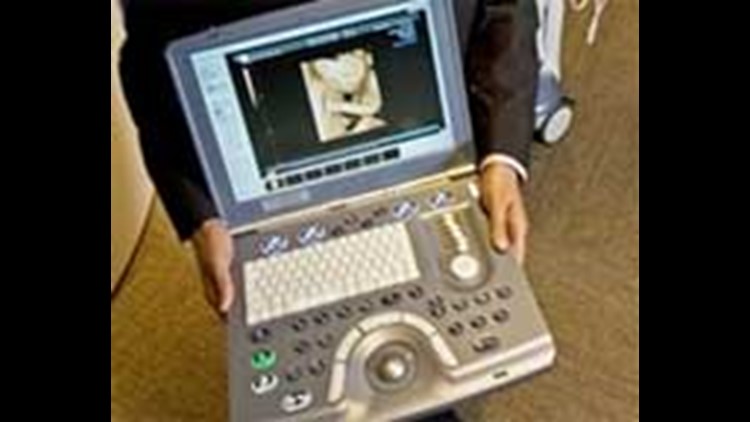But Dr. Simon Kotlyar wanted to confirm the diagnosis first. So the visiting doctor performed an ultrasound test using a new system - a machine miniaturized to the size of a laptop computer - and discovered the woman was only 32 weeks pregnant, not 40 weeks as anecdotal evidence had led doctors to believe.
"Having that system made a pretty big difference," said Kotlyar, chief resident in the department of emergency medicine at Yale-New Haven Hospital in Connecticut. "I told her to go home and come back in a few weeks."
As ultrasound machines become more compact and their image quality more precise, doctors have begun carrying the body-imaging technology to rural U.S. hospitals and developing countries. No longer is ultrasound available only to hospitals with reliable power supplies and room for bulky equipment.
The fledgling industry of portable ultrasound units has grown rapidly the past two years and it's expected to become an even bigger part of the ultrasound market. It is dominated by SonoSite Inc. of Bothell, Wash., and GE Healthcare, based in the Milwaukee suburb of Wauwatosa. Each commands about 40 percent of the worldwide market, according to industry expert Harvey Klein.
SonoSite pioneered the technology of hand-carried units in 1999. Industry leader GE Healthcare entered that market later - in 2002. Officials there said they had already planned their own line of portable units and SonoSite's entrance didn't alter their long-term strategy.
Cruder versions of portable ultrasound equipment have been around for almost 30 years but SonoSite was the first to produce images of usable quality, said Klein, president of Klein Biomedical Consultants in New York City.
The portable battery-operated machines aren't expected to replace standard console-sized units, just as laptop computers haven't rendered desktop models obsolete. But Klein said the compact machines are proving popular among doctors outside the traditional areas of radiology, cardiology and prenatal care.
"There are maybe 20 specialty areas - emergency medicine, anesthesiology - that represent new markets," he said. "There's plenty of interest here."
Ultrasound produces real-time imaging of a beating heart or developing fetus by interpreting sound waves bounced off solid internal objects.
Other common techniques for exploring inside the body without surgery include MRI - magnetic resonance imaging - systems that yield vivid results but whose scans require the patient to lie still for minutes. X-rays are still popular for producing images of bones, but the technology exposes a patient to potentially harmful radiation.
Ultrasound has its own drawbacks. Its effectiveness depends on operators knowing precisely how to position patients and where to place the imaging probes to reveal the best views.
To doctors, image quality is key. The newer compact units can now produce images comparable to those of the higher-end console units about 90 percent of the time, said Dr. Craig Sable of the Children's National Medical Center in Washington, D.C.
In 2003, Sable brought a portable unit to Uganda, where he used it to diagnose a life-threatening heart ailment in a 2-year-old girl. She later had successful surgery in the U.S.
"There are dozens of other patients just like that," the pediatric cardiologist said. "This technology still has a ways to go but it has tremendous potential."
GE Healthcare said the market for portable ultrasound is small but its business is growing rapidly, with sales of $174 million in 2006, a 74 percent increase over 2005.
That figure was about one-tenth of the company's $1.6 billion in sales of all ultrasound equipment, including the traditional machines so large that they are wheeled around on carts.
SonoSite makes only hand-carried units. Its systems have been used by the U.S. military in Afghanistan and Iraq as well as in Louisiana after Hurricane Katrina, company spokeswoman Ann Bugge said.
"Traditional ultrasound machines weigh hundreds of pounds. They're mounted on wheels but they're about as easy to move as your refrigerator," Bugge said. "Our systems all weigh between 3 and 7 pounds."
SonoSite had revenues of $171.1 million in 2006, a 16 percent increase over 2005 revenue. The cost of its hand-carried models has remained steady, from about $15,000 to around $50,000 depending on features.
GE Healthcare expects demand to remain strong both for full-sized units - which range from $30,000 to more than $200,000 - and the portable units - which cost $25,000 to $90,000.
"We see customers buying both," said Omar Ishrak, chief executive of the GE division's clinical-systems business unit. "In traditional markets where mobility isn't as important, they'll want the consoles with the higher-end technology."
Ultrasound makers hope that miniaturized equipment will make the technology more popular among doctors domestically and abroad.
Klein estimated the worldwide market for ultrasound machines at $4 billion last year, with about 10 percent coming from sales of portable units. The market will exceed $5 billion in 2011 of which more than 20 percent will come from portable-unit revenue, he predicted.
Kotlyar, the doctor who volunteered in Africa, said his Liberian patients were excited and grateful to have access to ultrasound images, especially since their country's health care system was ravaged in a civil war that ended in 2003.
"The women loved the notion of seeing the baby in their belly," he said. "I think it was incredibly uplifting for people who had not had a lot of positives in their health sector in a long time."
(Copyright 2007 Associated Press. All rights reserved. This material may not be published, broadcast, rewritten, or redistributed.)



